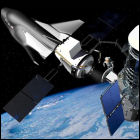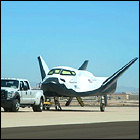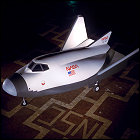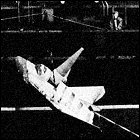Dream Chaser Hubble repair mission proposed
 Though it has yet to actually go to space, the Sierra Nevada Dream Chaser spacecraft is floated as a possible savior for the Hubble Space Telescope, with a very preliminary mission proposal for a repair mission to the telescope which has now been operational in orbit for over a quarter of a century. The possible mission is brought forth as an example of increasing high-profile cooperation between NASA and private space companies. The Dream Chaser’s earliest orbit test flights are not expected to take place prior to 2019; if the mission takes place in 2020 at the earliest, Hubble will by then be 30 years old.
Though it has yet to actually go to space, the Sierra Nevada Dream Chaser spacecraft is floated as a possible savior for the Hubble Space Telescope, with a very preliminary mission proposal for a repair mission to the telescope which has now been operational in orbit for over a quarter of a century. The possible mission is brought forth as an example of increasing high-profile cooperation between NASA and private space companies. The Dream Chaser’s earliest orbit test flights are not expected to take place prior to 2019; if the mission takes place in 2020 at the earliest, Hubble will by then be 30 years old.
Dream Chaser test vehicle on the runway
 A full-sized structural test article of Sierra Nevada Corporation’s Dream Chaser spacecraft begins “tow tests” at NASA’s Dryden Flight Research Center, verifying the vehicle’s handling on landing gear after touching down. Drop tests and glide tests are scheduled for later in 2013, though all such tests will be completely automated. Sierra Nevada Corporation also provides the main engines for Virgin Galactica’s SpaceShipTwo, and had already built the engines that propelled SpaceShipOne toward its X Prize-winning flight. The Dream Chaser design is based on an unused study vehicle, HL-20, studied by NASA in the 1980s and ’90s, which was in turn based upon a Soviet-era test vehicle called BOR4.
A full-sized structural test article of Sierra Nevada Corporation’s Dream Chaser spacecraft begins “tow tests” at NASA’s Dryden Flight Research Center, verifying the vehicle’s handling on landing gear after touching down. Drop tests and glide tests are scheduled for later in 2013, though all such tests will be completely automated. Sierra Nevada Corporation also provides the main engines for Virgin Galactica’s SpaceShipTwo, and had already built the engines that propelled SpaceShipOne toward its X Prize-winning flight. The Dream Chaser design is based on an unused study vehicle, HL-20, studied by NASA in the 1980s and ’90s, which was in turn based upon a Soviet-era test vehicle called BOR4.
HL-20: the mini-shuttle that almost was
 NASA begins intensive work, including the construction of a full-sized test article, on the HL-20, a vehicle being considered for “assured access” to the space station NASA plans to build in the 1990s. HL-20 is based upon the scale-model unmanned BOR4 vehicle test-launched four times by the Soviet Union, and testing will get as far as NASA conducting simulations to determine seating and cargo placement. Despite the relatively recent Challenger disaster, the HL-20 project is quietly dropped in the early 1990s since no urgent need is seen on a widespread basis throughout NASA to phase out or replace the Space Shuttle. The design will be revived in the 21st century by Sierra Nevada Corproation as the proposed Dream Chaser vehicle.
NASA begins intensive work, including the construction of a full-sized test article, on the HL-20, a vehicle being considered for “assured access” to the space station NASA plans to build in the 1990s. HL-20 is based upon the scale-model unmanned BOR4 vehicle test-launched four times by the Soviet Union, and testing will get as far as NASA conducting simulations to determine seating and cargo placement. Despite the relatively recent Challenger disaster, the HL-20 project is quietly dropped in the early 1990s since no urgent need is seen on a widespread basis throughout NASA to phase out or replace the Space Shuttle. The design will be revived in the 21st century by Sierra Nevada Corproation as the proposed Dream Chaser vehicle.
BOR4: the mini-shuttle that almost was
 The Soviet Union launches a scaled-down test model of a compact space shuttle design into orbit, part of an ultimately abandoned study of a vehicle design called Spiral. The BOR4 structural test article is photographed being recovered from the Indian Ocean by the Australian government, revealing the design to the western world for the first time. NASA begins a study of the BOR4 lifting body design, finding that it has a stable flight profile and unusually good reentry and landing characteristics, and though NASA’s version of the vehicle, HL20, is later mooted as a shuttle replacement, both countries’ space agencies pass on the design, which will later be revived by Sierra Nevada Corporation as the Dream Chaser. BOR4 is launched three more times through 1984, at which point the Soviets instead press ahead with development of Buran, a near-exact copy of the American Space Shuttle.
The Soviet Union launches a scaled-down test model of a compact space shuttle design into orbit, part of an ultimately abandoned study of a vehicle design called Spiral. The BOR4 structural test article is photographed being recovered from the Indian Ocean by the Australian government, revealing the design to the western world for the first time. NASA begins a study of the BOR4 lifting body design, finding that it has a stable flight profile and unusually good reentry and landing characteristics, and though NASA’s version of the vehicle, HL20, is later mooted as a shuttle replacement, both countries’ space agencies pass on the design, which will later be revived by Sierra Nevada Corporation as the Dream Chaser. BOR4 is launched three more times through 1984, at which point the Soviets instead press ahead with development of Buran, a near-exact copy of the American Space Shuttle.